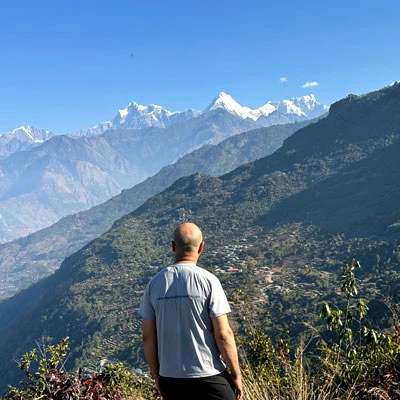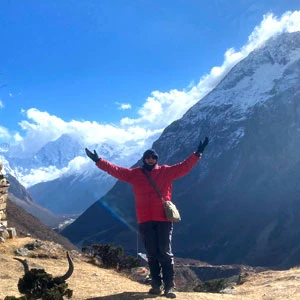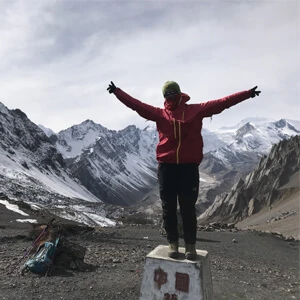What is the Annapurna Circuit Trek?
The Annapurna Circuit Trek is a two-week trek through the Himalayas of Nepal that features incredible mountainous landscapes, comfortable accommodations, and the rich culture of the local people. It is one of the most famous treks in the world and has been highly sought after since being opened to the public in 1977. The trekking circuit dramatically weaves its way through the protected Annapurna Conservation Area in the Manang and Mustang districts of Nepal. Nature lovers can get their fill on the Annapurna Circuit, from the flowing rivers to the towering mountains. This trek is well-traveled and well-loved.
Annapurna Circuit Trekking Facts:
- Max Elevation: 5416 meters (17769 feet)
- Accommodation: Tea House
- Duration of the Trek: 16 Days
- Activity: Trekking/Hiking
- Trekking Difficulty: Strenuous
- The best time to visit: March to May and September to November
- Group Size: 1 to 20
- Trek Starts: Kathmandu
- Trek Ends: Pokhara/Kathmandu
Annapurna Circuit Trekking Glance:
- Mixed of different religious people and their unique culture
- Lush jungle and numerous waterfalls
- One of the highest glacial lakes, at 4920 meters
- The oldest Braga monasteries
- Thorong La Pass, 5416 meters
- Famous Hindu shrines include Muktinath Temple and Kagbeni Village.
- Lush-to-extremely dry landscape
- Organic Apple Farming
- The warm hospitality of the Thakali people, their mouth-watering meals, and their culture
- Two of the tallest mountains in the world, Dhaulagiri (8167 meters) and Annapurna (8091 meters)
- Hot Spring at Tatopani
- The opportunity to combine an isolated Upper Mustang Trek, Nar Phu Valley Trek, Annapurna Circuit with the Tilicho Lake Trek, Ghorepani Poon Hill Trek, and Annapurna Base Camp Trek

What is the Manaslu Circuit Trek?
Manaslu Circuit Trekking Facts:
- Max Elevation: 5106 meters (16752 feet)
- Accommodation: Tea House
- Duration of the Trek: 17 Days
- Activity: Trekking/Hiking
- Trekking Difficulty: Strenuous
- The best time to visit: March to May and September to November
- Group Size: 2 to 20
- Trek Starts: Kathmandu
- Trek Ends: Kathmandu/Pokhara
The Manaslu Circuit is an adventurous trekking route that encircles Mt. Manaslu, the 8th highest mountain in the world. The gorgeous teahouse trek has been quickly growing in popularity since its opening to the public in 1992. Although open, the Manaslu Conservation Area, located in the Gorkha district, is still technically restricted, meaning that permits and a local guide are required to explore the region. This limits crowds along the Manaslu Circuit while maintaining the pure beauty of the breathtaking landscapes. Travelers can expect a culturally immersive experience as they trek through the impressive mountains, rustic fields, and lush forests.
Manaslu Circuit Trekking Glance:
- The eighth-tallest mountain in the world, Mt. Manaslu, is 8163 meters high.
- Manaslu Base Camp
- Off-the beaten-path-trek
- Abundant waterfalls, along with magnificent mountain vistas
- Four different climate zones, such as tropical, sub-tropical, alpine, and arctic, are included in a trekking route.
- Invaluable flora and fauna
- Home of Tibetan Buddhism and monasteries
- Stunning side trips such as Serang Gompa, Prok village, Kal Tal, Hinnang Monastery, Pungen Gompa, Birendra Lake, the Tibet border, and Ponkar Lake
- Larkya Pass (5106 meters)

Food and Accommodation:
You can expect simple but cozy teahouses along the entire length of both treks. Teahouses are small hotels that offer trekkers rest spots, delicious food to order, and shared or private sleeping accommodations. The Annapurna region is more well established with lots of choice of teahouses compared to the less traveled Manaslu region. Teahouses in both regions specialize in local Nepali dishes (dal bhat is highly recommended!) while also offering Western classics such as pasta and burgers. The Annapurna region tends to have a greater abundance of food and snacks, as well as updated amenities and Western toilets.
Length and Difficulty:
The two circuits are comparable in length; both typically take groups an average of 16 days to complete. A short Annapurna Circuit Trek is about 12 days long, whereas you'll need a minimum of 16 days to complete the Manaslu Circuit Trek. The beauty of trekking in both the Annapurna Region and the Manaslu Region is that it's easy to extend your trek by combining the circuits with other spectacular treks in the region. For example, trekkers commonly plan the Annapurna Circuit Trek with Tilicho Lake or the Manaslu Tsum Valley Circuit Trek.
Both the Annapurna Circuit and Manaslu Circuit are graded as strenuous treks. This means long days of 6 to 7 hours, challenging terrain, and hiking at elevation. Proper conditioning and physical ability are required to tackle these infamous treks.
The Manaslu Circuit is slightly more challenging than the Annapurna Circuit in terms of the terrain, with some larger ups and downs at the beginning compared to the more consistent build of the Annapurna Circuit. There is also road access deeper into the start of the Annapurna Circuit, which means trekkers have the choice to hike the mountain road or take a Jeep.
The difficulty factor is important to consider when comparing the whole of the two circuits, as is the difficulty of their respective mountain passes, the highest elevation points.
The Mountain Passes:
Overall, the pass on the Manaslu Circuit, Larkya La (5106 meters), is more challenging than the pass on the Annapurna Circuit, Thorong La (5416 m). There are a few reasons that contribute to the Manaslu Pass being more challenging. In the two days leading up to Larkya La, there is a large jump in altitude. Between the small villages of Samdo (3875 m) and Dharamsala (4460 m), there is a 600 m elevation gain without any option to stop in between. This is a big jump for anyone not used to trekking at high altitudes, and it is often recommended to take a day for acclimatization here before the pass. The Annapurna Circuit offers many options leading up to the pass to acclimatize more slowly with day hikes and shorter distances between nights of sleep. You are in for a long but rewarding day tackling both passes; however, the hike up to Larkya La of the Manaslu Circuit is longer. Not only is the hike up to Larkya La longer than Thorong La, but the descent backward is longer and steeper (may all knees be warned), resulting in an overall more demanding day for trekkers.
The Experiential Feel:
The mountain views and landscapes along the Annapurna Circuit are endlessly astonishing. It has been named one of the best long-distance treks in the world, alongside the infamous Everest Base Camp Trek. As a result of it being such a highly sought-after destination for trekking enthusiasts, the area has been quite developed and well-maintained. Much of the experience of guests is spent with other travelers surrounded by more familiar comforts such as Western toilets, electricity, and WiFi.
The Manaslu Circuit is gaining popularity as trekkers seek the same Himalayan experience that the Annapurna Circuit offers without crowds. The Manaslu Circuit is less traveled and therefore less established so that guests can immerse themselves more authentically in the local culture. Although slightly less dramatic than Annapurna, there are still incredible mountain views that anyone would be lucky to enjoy.
There is no right or wrong when it comes to choosing between the two treks; it simply depends on the desires of the trekkers. Annapurna offers a more comfortable experience along a well-established trail through unimaginable beauty; Manaslu offers a more rugged, cultural experience through the mountains, better suited for a slightly more seasoned trekker.
Guides and Permits:
Although it is recommended to trek with a Nepali guide to support the local economy, the Annapurna Conservation Area does not require foreigners to go with a guide, and permits can be obtained independently. Permits for the Annapurna Circuit include:
The Manaslu Conservation Area is restricted to foreigners and requires a minimum of two trekkers to obtain the Manaslu special trekking permit, a government-registered agency, and a licensed guide. All the necessary trekking permits will be taken care of by the agency and during the trek your guide will take care of it.
- Manaslu Special Trekking Permit (available from Nepal Immigration in Kathmandu and Pokhara) - It costs $100 from September to November for the first seven days plus $15 for each additional day, and $75 from December to August for the first seven days plus $10 per additional day per person. Also, a minimum of two people is mandatory to obtain the Manaslu Circuit Trekking Permit. Trekkers are also required to have an Annapurna and Manaslu Conservation Area permit from the Nepal Tourism Board for 3000 Nepali rupees per person. For further details, go through the Nepal Trekking Permits and Fees Blog.
- Manaslu Conservation Area Project (MCAP) (Nepal Tourism Board, Kathmandu, and Pokhara) - It costs 3000 Rupees per person.
- Annapurna Conservation Area Project (ACAP) (Nepal Tourism Board, Kathmandu, and Pokhara) - Also, costs 3000 Rupees per person
For those interested in a solo adventure, the Annapurna Circuit is more appealing because they can obtain their permits and set their route. The trail is well-marked with plenty of teahouses and is easy enough to navigate without a guide.
As a result of the Manaslu Region being closed to tourists until recently and now requiring two people at minimum plus a guide to access it, it is slightly less traveled. This is, of course, more appealing to a different group of tourists: those seeking a quieter experience.
Having a guide truly elevates the experience for guests from arrival to departure, regardless of the trek. The best companies will offer airport transfers, arrange hotels in Kathmandu (the capital city of Nepal), and even go as far as helping guests plan the rest of their trip in Nepal. While trekking with a guide, people learn about the local culture and customs, practice the Nepali language (locals love hearing foreigners speak Nepali!), and gain a deeper appreciation for the land they are exploring.
Annapurna vs. Manaslu Trekking Gear Checklist
Clothing:
- Raincoat, poncho, or combination jacket/trousers
- One down jacket/Gore-Tex Jacket
- Windproof trousers
- Two pairs of hiking pants (depending on the duration of the trek)
- One pair of shorts
- Three to four T-shirts (depending on the duration of the trek)
- One fleece jacket
- One/two pairs of base layers
- Two to three pairs of hiking socks and a couple of pairs of thicker socks
- Two pairs of gloves—one pair light fleece, the other waterproof/windproof
- Undergarments
Footwear:
- Trekking boots (water resistance, ankle supportive)
- Flip-flops for leisure time around camp or one pair of sneakers
Other Equipment:
- Sunglass, sunscreen, lip balm, sun hat, woolen/fleece hat, first aid kit, Swiss army knife(optional), luggage cover, headlamp, trekking poles, gaiter (optional), micro crampons (optional), water purification tablets or Steripen, extra batteries, adapter, power bank, water bottles/camel bag/Thermos, washing powder/multi-purpose soap, shampoo, a small towel, antiseptic hand wash, toiletries, female hygiene products, wet wipes, mosquito spray (optional), whistle, earplugs, reading books, playing cards/chess
- Sleeping bag rated to minus 15/20 degrees Celsius (extreme temperature) depending on trekking route and season
- Backpack (60 liters)
- Daypack (25 to 30 liter)
Other Treks In These Regions:
When it comes to trekking through the Annapurna and Manaslu regions, much of the hype (and this article) is focused on the two mighty circuits; however, it's worth mentioning that there are many other incredible areas to explore in these regions. The Nepalese Himalayas are, no doubt, breathtakingly beautiful, but the experience of trekking through them is elevated by the rich culture of the local people. Choosing alternative routes or adding to the circuits takes trekkers to more remote areas where they can experience the culture more intimately.
Recommended Treks on the Annapurna Region:
Recommended Treks on the Manaslu Region:
Still can't decide? Do both!
Likely by now, you understand that both the Manaslu Circuit Trek and the Annapurna Circuit Trek are each spectacular in their own way. If you are planning a trip to Nepal, have the time, and have already been dazzled by the thought of both of these circuits, consider doing BOTH! The Manaslu Annapurna Circuit Trek combines both incredible treks into one, once-in-a-lifetime adventure! While you have already put all of the planning and effort into coming to Nepal, you might as well make the most of your 30-day tourist visa and spend it surrounded by the magic of the mountains and the warmth of the locals.









